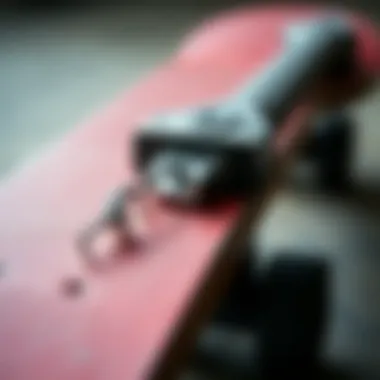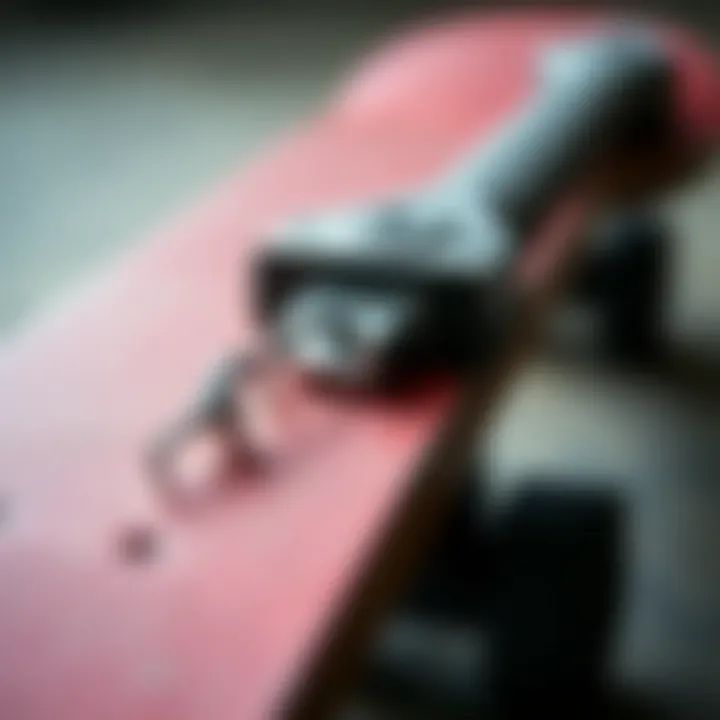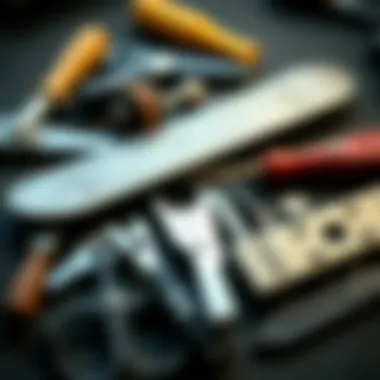Mastering Skate Sharpening at Home: A Complete Guide


Intro
Sharpening your skates at home is not just a practical skill; it’s a gateway to ensuring your performance on the rink is at its peak. When the ice is smooth and ready, the last thing you want is to be fumbling with dull blades. Understanding the nuances of skate sharpening can make a world of difference, enhancing not only your gliding ability but also your confidence as you carve through the ice.
This guide will walk you through the essential tools, methods, and techniques to master the art of skate sharpening. Even if you’re a beginner with little experience, or an old hat looking to refine your skills, you’ll discover valuable insights that can turn a daunting task into a routine part of your at-home preparation. Let's dive in!
Prolusion to Skate Sharpening
In the world of skating, having well-maintained skates can be the difference between a flawless glide on the ice and a frustrating struggle against dull blades. This is where learning how to sharpen skates at home becomes a significant skill for anyone involved in the sport. It’s not just about keeping your edges sharp; it’s about enhancing performance, ensuring safety, and prolonging the life of your skates.
For beginners, the concept of skate sharpening might seem daunting, full of technical jargon and intimidating tools. However, with a bit of basic knowledge, it can quickly become an accessible and rewarding practice. By developing this skill, you ensure that your blades are always in prime working condition, allowing for more fluid moves and better control on the ice.
Focusing on regular sharpening can transform your skating experience, reducing the risk of accidents due to worn-out blades. Beyond just performance, understanding skate sharpening can lead to more thoughtful care of your gear.
Understanding the Basics of Skate Blades
Before diving into the mechanics of sharpening, it's crucial to grasp the distinct components and designs of skate blades. Skate blades are typically made of high-carbon steel, providing a robust yet sharp edge essential for making quick turns and precise stops. The blade's profile, which is often a mix of various curves and angles, plays a pivotal role in how a skater interacts with the ice.
To break it down:
- Hollow: This refers to the concave groove along the bottom of the blade that allows for easier grip on the ice. The depth of the hollow affects stability and maneuverability. A deeper hollow might offer better grip, whereas a shallower one could improve speed.
- Radius: This determines how the skate turns and pivots. Different radii cater to various styles of skating, whether that's racy speed skating or agile hockey moves.
Equipped with this basic understanding, skaters can approach sharpening with a sharper eye—literally and metaphorically. Knowing how your blade works helps you make informed decisions on sharpening styles and frequencies, ultimately enhancing your skating experience.
The Importance of Regular Sharpening
Keeping your skate blades sharp is more than just a routine chore; it’s an essential part of optimizing your performance on the ice. By maintaining sharp edges, skaters can experience improved control, enhanced speed, and a more enjoyable overall skating experience. Let’s dive into why the act of sharpening your skates shouldn’t be taken lightly.
Impact on Performance
A sharp blade does wonders for your skating technique. When the edges are honed to perfection, they allow for better grip on the ice. This grip translates directly into your ability to accelerate, decelerate, and perform sharp turns without losing balance. If the blades are dull, the skate will slide more easily rather than gripping the ice, leading to less control and precision.
- Acceleration: Sharp blades dig into the ice, helping you take off quickly. Think of it as having the right tools for a job—trying to race with dull skates is like running with boots instead of sleek running shoes.
- Turning Radius: The sharper the edges, the tighter you can turn. Whether you're a figure skater executing a flawless axel or a hockey player dodging an opponent, those well-sharpened edges give you the agility you need.
- Confidence: With sharp skates, you can push yourself further. You can take those tight turns and quick stops, knowing your blades will respond exactly as you expect.
"A well-maintained edge is the silent partner in the dancer's routine on ice. It silently dictates grace, control, and precision."
A single poor sharpening session can disrupt your flow on the rink for weeks. So, regular upkeep is key—often, this means sharpening at least every couple of weeks or after several skating sessions. Knowing when to sharpen can be as crucial as the process itself; waiting too long can lead to performance lags.
Safety Considerations
It’s not just about performance; let’s talk safety. Dull blades can threaten more than just your ability to skate. If a blade is worn down, you may not stop as quickly as you'd like. This can potentially lead to accidents and injuries, both to yourself and others around you on the rink.
Here are a few safety points to ponder:


- Preventing Falls: If you’re struggling to grip the ice due to dull edges, you are at a higher risk of slipping and falling. Skating is about balance, and if your blades aren’t supporting you properly, your season could take a tumble.
- Avoiding Collisions: For hockey players, dull blades can make it difficult to maneuver around other players efficiently. This can lead to dangerous situations, especially during fast-paced games where a sudden stop or quick turn is necessary to avoid contact.
- Maintaining Focus: When you know your equipment is in optimum condition, you can concentrate fully on the game or the performance instead of worrying about your footing. Having confidence in your skates keeps your mind where it should be—on the ice.
Common Tools and Equipment
When it comes to sharpening skates, having the right tools and equipment is half the battle won. Not only do these tools affect the quality of the sharpening process, but they also play a pivotal role in ensuring the longevity of your skates. In this section, we’ll explore different types of sharpening tools available and considerations for choosing the right ones to make the whole sharpening experience smooth and efficient.
Types of Sharpening Tools
There’s an array of sharpening tools designed to cater to various needs and skills. Getting familiar with these tools can greatly enhance your skate maintenance regimen. Here’s a rundown of some common ones:
- Handheld Sharpeners: These are the most traditional tools. They come in various shapes and sizes, allowing you to manually sharpen your blades. They can be portable, which is a bonus for skaters who travel.
- Electric Sharpeners: While they tend to be pricier, electric sharpeners efficiently remove metal and can provide a consistent edge, particularly if you don’t have a steady hand. Convenience often trumps cost here, especially for those serious about their performance.
- Honing Bars: These aren’t used for sharpening per se, but they can help refine and polish the edges of your blades after using more abrasive tools.
- Grinding Wheels: A vital part of many electric sharpeners, these wheels come in different grits, impacting how much material gets removed during the sharpening process.
With so many options, the decision often boils down to personal preference and how frequently you sharpen your skates.
Choosing the Right Stone
The sharpening stone is arguably the most important tool in your kit. It’s essential to select the right one based on your skate type and personal needs. Here are some factors to consider:
- Material Composition: Stones can be made from various materials, including aluminum oxide or silicon carbide. Each material provides a different level of abrasiveness.
- Grit Size: The grit of the stone dictates how sharp the blade will be. Lower grit numbers mean coarser stones, ideal for reshaping edges, while higher numbers are finer, great for touch-ups.
- Flat vs. Radius: Some skaters prefer a flat edge, while others might need a concave edge to help with their turns. Knowing your preference helps in choosing the right stone.
Choosing the right stone can significantly impact your skate performance, so give it careful thought.
"A well-chosen stone can make the difference between a drudging skate and a sleek glide over the ice."
Preparing for the Sharpening Process
Before diving into the intricacies of sharpening skates, it’s crucial to set a solid foundation through proper preparation. Think of this stage as the warm-up before a big game. Preparing your skates and workspace will help ensure a smoother sharpening experience, which ultimately leads to better blade performance. This process not only enhances the effectiveness of your sharpening but also minimizes the chance of errors, providing both novice and experienced skaters with greater confidence in their skills.
Cleaning the Blades
Cleaning the blades is often overlooked, yet it’s an essential first step in the sharpening process. Dirt and debris can accumulate, not just on the surface but also in the grooves of the blade, affecting both the sharpening outcome and the overall glide. Here’s how to tackle it:
- Use a soft cloth or towel: A lint-free cloth works best because it won't leave fibers on the blade. Gently wipe the blades to remove any dirt or moisture.
- Check for rust: If you spot any rust, a specialized blade cleaner might be your best bet. Remember, a clean blade is a happy blade, leading to improved performance.
- Avoid harsh chemicals: Stick with mild detergents or blade-specific cleaners. You don’t want to damage the integrity of the blade material.
Taking the time to clean the blades will not only improve the quality of the sharpening but also extend the lifespan of your skates. This preparatory step is, therefore, a key part of maintaining overall equipment health.
Setting Up Your Workspace
Having a well-organized workspace can't be understated; it’s akin to having a good strategy before a competition. A clutter-free area allows you to focus on the task at hand without distractions. Here are some tips on how to set it up:
- Choose a stable surface: An even, hard surface is best. This ensures you can apply even pressure while sharpening. A table or workbench is ideal.
- Lighting is key: Good illumination helps you see the blade clearly, which is crucial when aiming for precision.
- Gather your tools: Make sure your sharpening tools, such as your stone or sharpener, and cleaning materials are within reach. This makes the process much more fluid.
- Minimize distractions: Turn off that TV and put your phone aside. Focus solely on the sharpening process to avoid mistakes.
In summary, the preparation phase is crucial. It sets the tone for what’s to come, ensuring that time spent sharpening results in blades that perform optimally on the ice. Whether you’re a casual skater looking to sharpen blades or someone who often laps the rink, taking these steps seriously makes all the difference.


"If you fail to prepare, you're preparing to fail."
— Benjamin Franklin
For further reading on best practices for maintaining skating equipment, consider checking sources like Wikipedia or discussions on Reddit.
By investing just a bit of time in preparation, you’ll be inching closer to mastering the art of skate sharpening.
Step-by-Step Sharpening Techniques
The methods you use when sharpening skates are crucial for maximizing performance and ensuring safety on the rink. A well-sharpened blade not only enhances maneuverability but can also reduce the likelihood of falls or accidents. Knowing how to properly sharpen your skates allows you to maintain control over your skating experience, making routine practice or recreational skating far more enjoyable. Investing time in learning these techniques can transform an ordinary glide into a thrilling ride, emphasizing the importance of precise blade maintenance.
Using a Manual Sharpener
When it comes to sharpening your skates with a manual sharpener, it’s important to have a steady hand. Manual sharpeners, like handheld stones or files, require a bit more effort and practice than their electric counterparts. They offer precise control, allowing you to focus on the specific areas of the blade that need attention.
- Angle Matters: Begin by identifying the angle at which you need to sharpen. Most skates are typically sharpened at a three-eighths to a half-inch hollow, but this can depend on personal preference or skating style. Keep a consistent angle throughout the process for the best results.
- Stroke Technique: With the sharpener in hand, start your strokes at the toe and work your way toward the heel. Maintain even pressure, and use long, smooth movements to ensure an even sharpening. Short, erratic strokes can create uneven edges, which will negatively impact your performance on the ice.
- Regular Checks: Periodically check your work by running your hand along the blade. You should feel a smooth edge; if there's any roughness or nicks, those areas may need additional attention.
Through practice, using a manual sharpener can help you develop a feel for your blades. Not only will you gain a better understanding of how your blades interact with ice, but you will also appreciate the nuances of sharpness that differ from one sharpening session to another.
Electric Sharpeners: Benefits and Usage
Electric sharpeners have grown in popularity due to their efficiency and ease of use. As these devices are designed for speed and uniformity, they can save you a great deal of time, making them ideal for both skaters and skate technicians.
- Quick and Consistent: Unlike manual sharpeners, electric models can produce a consistent edge quickly. This is great if you need to prep multiple pairs of skates in a short timeframe or if you're managing a skate rental business.
- Adjustable Settings: Many electric sharpeners come with adjustable settings right down to blade depth, giving you the flexibility to customize the sharpening to personal taste or specific skating styles.
- Less Physical Strain: With electric options, you avoid the physical fatigue that can sometimes come with manual sharpening. This is particularly beneficial if you have multiple pairs or you are working with high-quality, expensive skates where precision is key.
When using an electric sharpener, ensure that your machine is properly calibrated to maintain the integrity of your blades while sharpening. Follow the manufacturer’s guidelines to avoid damaging them.
How to Test the Sharpness
Determining whether your blades are sharp enough requires a hands-on approach. Here are some effective methods to test for optimal sharpness:
- Paper Test: A simple yet effective method is the paper test. Use a piece of paper and try to slice through it with the edge of the blade. If it cuts cleanly, your blades are in good shape. If it struggles or tears the paper, you know you’ve got some work to do.
- Finger Test: Another common technique is to lightly drag a fingertip across the blade. Be cautious—this test needs careful execution, as it can cause minor cuts. A sharp blade will feel like a mild scraping, whereas a dull blade will feel smooth with no resistance.
Remember, testing sharpness is not merely about accuracy; it's about ensuring your safety on the ice. Avoid pushing your blades with excessive force or using them if they are not adequately sharp.
By incorporating these techniques into your maintenance regimen, you’ll not only ensure that your skates remain in top condition but also enhance your personal skating experience. Regularly checking and sharpening your blades will allow you to glide with confidence, knowing that your skates are finely tuned for any challenge that the rink presents.
Addressing Common Issues
Sharpening skates is an essential skill for any skater, but it doesn't come without its challenges. Being aware of what can go wrong during the sharpening process and understanding how to tackle these common issues is crucial. This section sheds light on typical problems, equiping you with the knowledge to maintain blade integrity and even improve your sharpening skills.
Dealing with Nicks and Dings
Even the most careful skaters can find themselves with nicks and dings on their blades. These uninvited intrusions aren't just cosmetic – they can significantly affect performance. A blade with nicks can lead to a rough skating experience, causing you to lose control or stability. One common way to deal with this is through meticulous filing. Consider the following strategies:


- Identify the Problem Areas: Turn your skates upside down and study the blades. Look for any inconsistencies. A simple visual inspection often reveals issues right away.
- Use a File or Hone: For small nicks, a fine file made specifically for skate sharpening can work wonders. Gently run the file over the affected area in a swift motion, making sure not to alter the blade's shape drastically.
- Assess the Effectiveness: After addressing the nicks, it's time to test. Run your hand along the edge and feel for smoothness. If any resistance is felt, reevaluate and file again.
Regular maintenance, such as cleaning your blades after each use, can prevent many nicks from forming in the first place. Keeping an eye on your edges helps ensure they remain in prime condition. Furthermore, when skating in rough environments, such as outdoor rinks or uneven surfaces, lay extra emphasis on inspecting the blades post-session.
Preventing Over-Sharpening
Over-sharpening is a pitfall many skaters face, often leading to frustration. Unlike a fine wine, skate blades can’t just keep getting better with more sharpening – too much of a good thing can be counterproductive. Here's how to tread carefully:
- Know Your Blade's Tolerance: Different blade types require varying levels of sharpening. Understanding the specifications of your blades can guide how often and how much to sharpen them.
- Establish a Schedule: Instead of sharpening every time before hitting the ice, set a schedule based on how frequently you skate and the type of ice conditions you face. For example, if you skate twice a week on smooth rink ice, monthly sharpening might suffice.
- Use Gage Tools: Utilizing tools such as a blade depth gauge can help you measure how much material is removed during each sharpening session. This not only helps in avoiding over-sharpening but also extends the life of your skates.
This cautious approach to sharpening aids in maintaining the blade's optimal performance, ensuring your ice time remains enjoyable rather than a headache.
"Maintaining the sharpness of your skates is like fine-tuning a musical instrument. A small adjustment can make all the difference in performance."
In summary, addressing these common issues promptly can enhance your overall skating experience. By implementing diligent routines and preventative measures, you'll ensure that your skates remain in top shape, ready for every glide across the ice.
Post-Sharpening Maintenance
After sharpening your skates, what's next? You might think the work is done, but proper maintenance is vital for prolonging the life of your blades and ensuring peak performance on the ice. Post-sharpening maintenance involves two key aspects: effective storage techniques and consistent inspection. Taking these steps will not only help retain the sharpness you’ve just achieved but also keep your skates in top-notch condition for future use.
Proper Storage Techniques
Blade protection isn’t just a suggestion – it’s a necessity. After sharpening, it’s essential to store your skates properly. Here’s how:
- Use blade guards: Always equip your skates with decent blade guards right after sharpening. This will shield the edges from unwanted nicks and scratches. With the right guards, your blades aren’t just ‘safe’ but are also less likely to get damaged during transport.
- Avoid wet environments: Humidity is like a silent enemy to your skates. Store them in a dry location to prevent rust, which can quickly ruin those well-honed edges. A sweet spot is a cool, dry area, instead of a damp garage or a wet basement.
- Keep them upright: Whether it's in a locker or on a shelf, store your skates standing upright rather than laying flat. This helps in preventing blade warping and keeps the guards in their best form.
"Proper storage techniques ensure longevity and performance, keeping your investment safe for many skates to come."
In addition to storing them correctly, be mindful not to leave them in something like a damp bag for long periods. Get those damp skates out of the bag and allow them to dry naturally before you put them back away.
Regular Inspection Tips
Just like cars need regular check-ups, so do your skates. An occasional inspection can save you from unwanted surprises on the ice. Here are some handy tips:
- Look for nicks and dings: Regularly check your blades for imperfections. Even the tiniest nick can throw off your balance or your stride during skating.
- Flush out dirt and grime: After each use, wipe down your blades to remove any dirt, snow, or moisture. Water can lead to rust, and dirt can disrupt the smoothness of your glide.
- Check the sharpness: Every now and then, give your blades a gentle test. Run your thumb across the edge to feel if it’s still sharp or starts to feel dull. If you notice a lack of bite, it’s high time for a re-sharpen.
Being proactive and methodical with these inspections doesn’t just keep your skates running smoothly; it builds familiarity with your gear. Familiarity can grant you deeper insights into your own style and needs as a skater.
End and Final Thoughts
As we wrap up this comprehensive guide, it is essential to stress that skate sharpening isn’t merely a chore; it’s a crucial aspect of your skating journey. Maintaining sharp edges on your skates not only boosts performance but also enhances safety on the ice. The right sharpen makes all the difference, whether skimming across the rink or making that last-minute save.
Quality sharpening is not about how often you do it, but rather about how well you do it. With the correct techniques and tools, any skater can manage their skate maintenance at home. Learning these skills can lead to greater confidence while skating and help avoid common pitfalls like over-sharpening or neglecting maintenance altogether.
Emphasizing the Importance of Skill Development
Becoming proficient in skate sharpening is an investment of your time and effort. Just like mastering a trick or a new move on the ice, understanding the nuances of skate care opens up a world of possibilities.
Developing these skills enhances not just your performance but also your overall experience on the ice.
Consider the following benefits:
- Confidence Boost: Knowing your skates are well-maintained gives you peace of mind to focus on your technique instead of worrying about the state of your equipment.
- Cost-Effective: Investing time into sharpening your skates saves you both money and hassle, eliminating the need for frequent professional services.
- Customization: As you develop your skills, you’ll start to recognize what works best for you—whether it’s the specific angle or type of sharpen that meets your skating style.















